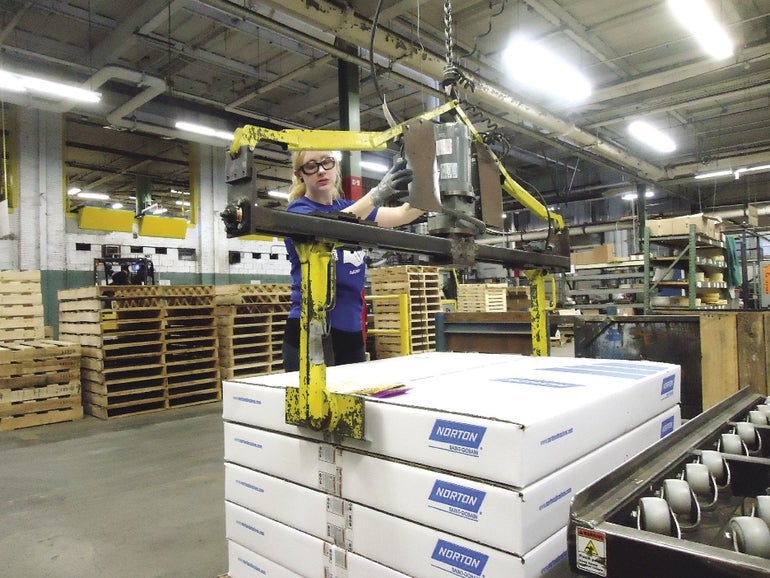Manufacturers reaching out to traditional high schoolers
 PHOTO | Courtesy of Saint-Gobain
A manufacturing worker at Saint-Gobain Abrasives in Worcester
PHOTO | Courtesy of Saint-Gobain
A manufacturing worker at Saint-Gobain Abrasives in Worcester
In the Blackstone Valley, even with its history as the birthplace of the American Industrial Revolution, it can sometimes be hard for parents to wrap their heads around manufacturing as a viable career path for their kids. Baby Boomers and Generation Xers hear “manufacturing,” and their minds often jump to the loud, dirty factories where they might have worked years ago until those jobs were shipped overseas to lower-cost places like China and Mexico.
But this is an area with legacy manufacturing companies in need of qualified employees, especially because the industry is facing a shortage of about 100,000 workers by 2022. The state's vocational schools help to funnel people through the workforce pipeline, but many of these schools have long wait lists and an increasing number of students heading off to four-year colleges.
“There is a huge misconception that manufacturing is like what it was when I was growing up – old dirty plants, and long work hours, like during the Industrial Revolution,” said Paul Lynskey, executive director of the Blackstone Valley Education Foundation. “When you walk into one of the manufacturers I'm dealing with now, they're spotless, with advanced technology. They offer very good paying positions, with multiple career options within them.”
That is why the latest industry efforts on workforce development focus on traditional high schoolers and adults, rather than those already in vocational schools or on a college career path.
Starting them young
School districts, businesses, and the state government developed a standardized credentialing system to help push people through the workforce pipeline. The credentialing system is offered through the Manufacturing Advancement Center Workforce Innovation Collaborative (MACWIC), a grassroots effort from businesses, educational institutions, the government, and the Massachusetts Manufacturing Extension Partnership in Worcester
The MACWIC curriculum, developed by employers and called the Applied Manufacturing Technology Pathway Certification, is an industry-recognized, stackable credentialing system that standardizes manufacturing skills training through five levels. Anyone – from a high school student looking for a hands-on job or an older worker in need of new skills – can get MACWIC certification, which, depending on the level, can count towards a certificate or an associate's degree at Quinsigamond Community College.
“For high school students, that's a great incentive,” said Kathy Rentsch, MACWIC member and dean of the School for Business, Engineering & Technology at QCC. “They're basically doing work in high school that will give them some college credit if they decide to come here.”
This year, the Blackstone Valley Education Foundation will pilot a Level 1 MACWIC certification program for students in the 11 school districts it represents with the help of a $48,750 grant.
The idea is to catch kids who might benefit from a vocational education but couldn't get into the vocation school in their area, and to enhance the manufacturing workforce pipeline. If the program is successful, there is interest in bringing it to traditional schools statewide, said Lynskey.
Education/business collaborative
MACWIC was established in 2012, as a grassroots collaboration between employers, MassMEP, schools and state officials with the idea of setting standards for manufacturing competencies to make hiring easier for employers, and to expand access to manufacturing training. It has since received approval from the Massachusetts Department of Education.
“I could graduate from Assabet [Valley Regional Technical High School] and you could graduate from Blackstone Valley, and we could take an exam and have completely different results, and there was no way to certify,” said Tom Wesley, a director of operations strategy at Milford laboratory equipment manufacturer Waters Corp. and head of the MACWIC steering committee. “We tried to standardize the curriculum.”
There are five levels of MACWIC certification, according to MassMEP. Level 1, which will be offered at Blackstone Valley schools, teaches shop math, blueprint reading, and safety, to name a few skills, and prepares people for jobs as entry-level assemblers or warehouse workers, at what Wesley calls “ready to learn” certification.
Those with Level 2 certification, or people who are “ready to earn,” are also considered entry level and can work as machine operators and inspectors. At Levels 3-5, students are qualified for middle skills jobs as machine operators, quality assurance workers and supervisors, machinists and managers.
Early success
Today, MACWIC has more than 200 member companies, who represent a combined 27,000 employees and more than $8 billion in revenues, according to MassMEP.
So far, 326 workers have reached Level 3 certification, and 93 percent of those people have jobs. The economic impact of those workers is estimated to be $181.8 million.
“In general, [MACWIC] has had a significant impact on the availability of specifically skilled and credentialed talent the employers need,” said Ted Bauer, director of workforce development strategies at MassMEP.
Solving the vocational equation
Out of the commonwealth's vocational schools, 29 out of 33 follow the pathway and give students the opportunity to get certified at Levels 1 and 2, according to MassMEP.
Last year, the Baker Administration dispensed $2.6 million in Workforce Skills Capital Grants to vocational high schools, community colleges and MassMEP.
But vocational schools have long waiting lists and are increasingly attracting high-performing students who later go on to enroll in four-year colleges. According to a 2015 report from Northeastern University's Dukakis Center for Urban and Regional Policy, almost 57 percent of students at vocational schools go on to postsecondary education, compared with 78 percent at traditional high schools.
A 2012 report from the Dukakis Center predicted manufacturing employers will have to hire more than 100,000 replacement workers by 2022.
Roping in traditional students
That's where the Blackstone Valley program comes in, Lynskey said.
“When military required many more officers than service academies could provide, they did not build four or six West Points points twice the size of Annapolis – they extended it to the regular colleges with Reserve Officers' Training Corps (ROTC). This is the same thing,” he said. “[Graduates] will not be as well prepared as a student going to Blackstone Valley [Regional Technical High School] for manufacturing. The problem is the need is going to be greater than the amount of graduates vocational educational programs can produce.”













0 Comments